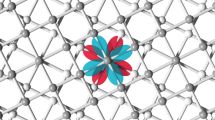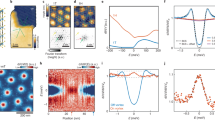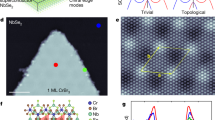Abstract
How small can a sample of superconducting material be and still display superconductivity? This question is relevant to our fundamental understanding of superconductivity, and also to applications in nanoscale electronics, because Joule heating of interconnecting wires is a major problem in nanoscale devices. It has been shown that ultrathin layers of metal can display superconductivity1,2,3, but any limits on the size of superconducting systems remain a mystery. (BETS)2GaCl4, where BETS is bis(ethylenedithio)tetraselenafulvalene, is an organic superconductor, and in bulk it has a superconducting transition temperature Tc of ∼8 K (ref. 4) and a two-dimensional layered structure5,6,7 that is reminiscent of the high-Tc cuprate superconductors8,9. Here, we use scanning tunnelling spectroscopy to show that a single layer of (BETS)2GaCl4 molecules on an Ag(111) surface displays a superconducting gap that increases exponentially with the length of the molecular chain. Moreover, we show that a superconducting gap can still be detected for just four pairs of (BETS)2GaCl4 molecules. Real-space spectroscopic images directly visualize the chains of BETS molecules as the origin of the superconductivity.
This is a preview of subscription content, access via your institution
Access options
Subscribe to this journal
Receive 12 print issues and online access
$259.00 per year
only $21.58 per issue
Buy this article
- Purchase on Springer Link
- Instant access to full article PDF
Prices may be subject to local taxes which are calculated during checkout




Similar content being viewed by others
References
Qin, S., Kim, J., Niu, Q. & Shih. C.-K. Superconductivity at the two-dimensional limit. Science 324, 1314–1317 (2009).
Özer, M. M., Jia, Y., Zhang, Z., Thompson, J. R. & Weitering, H. H. Tuning the quantum stability and superconductivity of ultrathin metal alloys. Science 316, 1594–1597 (2007).
Zhang, T. et al. Superconductivity in one-atomic-layer metal films grown on Si(111). Nature Phys. 6, 104–108 (2010).
Kushch, N. D. et al. New BETS salts based on magnetic (CuCl3, FeCl4) and non-magnetic (GaCl4) anions. Adv. Mater. Opt. Electron. 7, 57–60 (1997).
Uji, S. et al. Magnetic-field-induced superconductivity in a two-dimensional organic conductor. Nature 410, 908–910 (2001).
Kobayashi, H., Tomita, H., Udagawa, T., Naito, T. & Kobayashi, A. New organic superconductor λ-(BETS)2GaCl4 and metal–insulator transition of BETS conductor with magnetic anions (BETS = bis(ethlenedithio)tetraselenafulvalene). Synthet. Metals 70, 867–870 (1995).
Kobayashi, H. et al. A new organic superconductor, λ-(BEDT-TSF)2GaCl4 . Chem. Lett. 9, 1559–1562 (1993).
Bednorz, J. G. & Müller, K. A. Possible high Tc superconductivity in the Ba–La–Cu–O system. Z. Phys. B 64, 189–193 (1986).
Beno, M. A. et al. Structure of the single-phase high-temperature superconductor YBa2Cu3O-delta. Appl. Phys. Lett. 51, 57–59 (1987).
Jérome, D., Mazaud, A., Ribault, M. & Bechgaard, K. Superconductivity in a synthetic organic conductor (TMTSF)2PF6 . J. Physique Lett. 41, L95–L98 (1980).
Nam, M.-S., Ardavan, A. S., Blundell, J. & Schlueter, J. A. Fluctuating superconductivity in organic molecular metals close to the Mott transition. Nature 449, 584–587 (2007).
Kanoda, K. Electron correlation, metal–insulator transition and superconductivity in quasi-2D organic systems, (ET)(2)X. Physica C 282, 299–302(1997).
Kanoda, K. Recent progress in NMR studies on organic conductors. Hyperfine Interactions 104, 235–249 (1997).
Mielke, C. et al. Superconducting properties and Fermi-surface topology of the quasi-two-dimensional organic superconductor λ-(BETS)2GaCl4 (BETS = bis(ethylene-dithio)tetraselenafulvalene). J. Phys. Condens. Matter 13, 8325–8345 (2001).
Brooks, J. S. Superconductivity in Organic Conductors 463–493 (Springer, 2007).
Powell, B. J. & McKenzie, R. H. Strong electronic correlations in superconducting organic charge transfer salts. J. Phys. Condens. Matter 18, R827–R866 (2006).
Takabayashi, Y. et al. The disorder-free non-BCS superconductor Cs3C60 emerges from an antiferromagnetic insulator parent state. Science 323, 1585–1590 (2009).
Kobayashi, H., Cui, H. & Kobayashi, A. Organic metals and superconductors based on BETS (BETS = bis(ethylenedithio)tetraselenafulvalene). Chem. Rev. 104, 5265–5288 (2004).
Schrieffer, J. R. Theory of Superconductivity (W. A. Benjamin, 1964).
Kohsaka, Y. et al. How Cooper pairs vanish approaching the Mott insulator in Bi2Sr2CaCu2O8+δ . Nature 454, 1072–1078 (2008).
Pasupathy, A. N. et al. Pairing interaction in the high-Tc superconductor Bi2Sr2CaCu22O8+δ . Science 320, 196–201 (2008).
Arai, T. et al. Tunneling spectroscopy on the organic superconductor k-BEDT-TTF2Cu(NCS)2 using STM. Phys. Rev. B 63, 104518 (2001).
Ichimura, K., Takami, M. & Nomura, K. Direct observation of d-wave superconducting gap in κ-(BEDT-TTF)2Cu[N(CN)2]Br with scanning tunneling microscope. J. Phys. Soc. Jpn 77, 114707 (2008).
Hla, S.-W. STM single atom/molecule manipulation and its application to nanoscience and technology. J. Vac. Sci. Technol. B 23, 1351–1360 (2005).
Perdew, J. P., Burke, S. & Ernzerhof, M. Generalized gradient approximation made simple. Phys. Rev. Lett. 77, 3865–3868 (1996).
Ozyuzer, L. et al. Tunneling spectroscopy of Tl2Ba2CuO6 . Physica C 320, 9–19 (1999).
Tanatar, M. A., Ishiguro, T., Tanaka, H., Kobayashi, A. & Kobayashi, H. Anisotropy of the upper critical field of the organic superconductor λ-(BETS)2GaCl4 . J. Supercond. 12, 511–514 (1999).
Acknowledgements
The authors would like to thank the US Department of Energy (Basic Energy Sciences; DE-FG02-02ER46012), the Ohio University Bionanotechnology Initiative and the Ohio Supercomputing Center (PHS0275).
Author information
Authors and Affiliations
Contributions
S.W.H. and A.H. conceived and designed the experiments. K.C., A.H. and S.K. performed the STM experiments. K.C., S.W.H. and A.H. analysed the data. K.F.B. performed the DFT calculation. H.T. performed synthesis and X-ray diffraction characterization of the molecular crystals. S.W.H. and A.H. co-wrote the paper. All the authors discussed the results and commented on the manuscript.
Corresponding authors
Ethics declarations
Competing interests
The authors declare no competing financial interests.
Supplementary information
Supplementary information
Supplementary information (PDF 797 kb)
Rights and permissions
About this article
Cite this article
Clark, K., Hassanien, A., Khan, S. et al. Superconductivity in just four pairs of (BETS)2GaCl4 molecules. Nature Nanotech 5, 261–265 (2010). https://doi.org/10.1038/nnano.2010.41
Received:
Accepted:
Published:
Issue Date:
DOI: https://doi.org/10.1038/nnano.2010.41
This article is cited by
-
Tunneling properties of electromagnetic wave in slab superconducting material
Optoelectronics Letters (2011)
-
A dash of salt is superconducting
Nature Nanotechnology (2010)
-
Research highlights
Nature Physics (2010)



